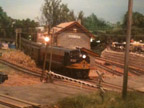
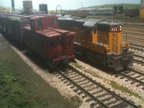
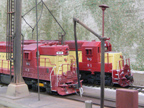

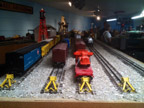
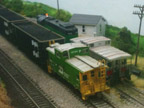
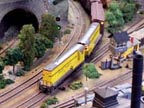
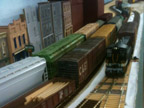
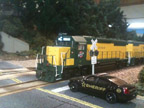
 |
 |
 |
 |
 |
 |
 |
 |
 |
Optoberfest 2012 is dedicated to the memory of Wayne Hammelman
Welcome to Milwaukee Optoberfest 2012.
Optoberfest, like its spring counterpart Milwaukee Operating Day, is an opportunity to spend a day, or part of one, operating on model railroads in southeastern Wisconsin that you may not have had the chance to operate before. Whether you consider yourself a novice or expert operator, with new crews on each layout almost everyone is a newbie at these sessions. Each host has helpers to be your pilot over the line the first run or two (if you want it) and answer any questions you may have. In short, it is a great opportunity to experience operation on some unique layouts and an educational opportunity for what operating systems, and even layout design, may or may not work on your own model railroad.
Unlike previous Milwaukee Operating Days/Optoberfests, there are some new features for this one. First and formost is this web site. Hopefully, it will give you far more information on the layouts than what was available in the past. As you scroll down, click on the links below, or the photos above, you will noticed each railroad has a table providing basic information about it, and links to more information if available. It also features a list of operators who are already registered, so you know how many, if any, positions are open when you make your selection. For those who factor in driving distance in their selection process, there is link to a map showing the locales of the participating layouts (these are not the exact locations, just the communities) so you can roughly plan your route. The bottom of this page also has a FAQ and a number of links to resources you may find helpful.
There are nine layouts participating this fall, the most ever, in scales ranging from HO to three-rail O to standard two-rail O. As you read through the descriptions you will see that the control systems, operating schemes and car routing methods vary greatly. As for technology, one layout has the ability to let you use your smart phone as a throttle and another layout has gone paperless, connecting to the JMRI Operations software with a tablet (iPad or tablet) - the owner will provide the tablets.
The participating layouts are listed in their respective sections below.
| Morning Section | Afternoon Section | Evening Section |
|---|---|---|
| Ashland Superior & Pacific | BN Peoria Subdivision | Midwest Lines |
| Norfolk & Whey | Lionelville & Western | Norfolk & Whey |
| UP & Western | Shenandoah Valley & Gulf | |
| West Wisconsin | ||
| Trap & Garnet Ridge | ||
| Map of Participating Layouts | ||
For those interested in what sessions are like, you can view some pics of Milwaukee Operating Day - March 2012.
Section Sessions: Optoberfest is divided into three sections; morning, afternoon and evening. Sessions in the morning section start at 9:00 a.m. and run until 12 noon. The afternoon sessions start at 2:00 p.m. and run until 5:00 p.m. (unless noted). Evening sessions start at 7:00 p.m. Please arrive between 30 and 15 minutes early so you have time to get orientated with the layout and the host can proptly start the session. There is a two-hour gap between sessions to allow for lunch or dinner (both on your own) and commuting to the next layout. While most layouts are in the Milwaukee metro and Raine area, one is in the Eklhorn area and the start time for that is offset to allow for drive time.
Youth Operators: Operators between the ages of 12-16 are welcome but must operate with a parent/grandparent (and both will be counted as one operator position). Operators between the ages of 16-18 may operate independently if accompanied by a participating parent/grandparent.
Extra Board: Once the minimum crews for all layouts are filled, some layouts have extra positions which will be made available.
Registration: If you are interested in participating, please review the layouts availble for morning, afternoon and evening sections and submit your first and second pick for each time period via the registration form link below. All assignments will be on a first-received, first-assigned basis and will hopefully be posted within 48 hours of your submission (remember, this is a volunteer operation). If your first selection is full, the second one will be assigned and after that the coordinator gets to pick. Keep in mind that many of the particpating layouts can only handle a small number of operators, so some fill up quickly. Fortunately there are two of these events a year, so what you don't get now you may be able to operate on in six months at Milwaukee Operating Day.
Registration for Optoberfest is now closed.
| Click here for the registration form. |
A week or so before Optoberfest, you will receive an email with the addresses and contact information for your hosts. Creating maps will be on your own, and can be done via Google Maps or whatever means (Garmin GPS, Tom Tom, etc.) you have at your disposal.
Be Courtious: Take pictures and memories, leave equipment, car cards, train cards, radios and throttles.
Most Important Rule: Have FUN! That's why the hosts volunteer their layouts, their helpers assist and I organize it.
The Dedication: Optoberfest 2012 is dedicated to the memory of Wayne Hammelman, who passed away on Monday, August 27. Wayne was a well-known and very active model railroader in the Milwaukee-area until he moved to Texas a few years ago. As someone who enjoyed operating on many of the layouts in the area, and being part of the Old Codgers Club operating group, it was decided to dedicate this year's event in his memory. You can see pictures of his rebuilt Black Hills & Western railroad in Texas by clicking here.
If you have any questions, feel free to send me an email.
And as a reminder, this is NOT a WISE Division, NMRA event.
Joe Russ
Update 10/26/12: Registration for Optoberfest is now closed.
| Morning Section |
|---|
All morning sessions start at 9:00 a.m. and go until noonish. Please arrive between 8:30 a.m. and 9:00 a.m. so you have time to familiarize yourself with the railroad before the session begins. |
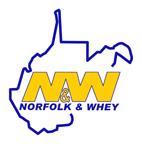 |
The Norfolk & Whey Railroad, also referred to as the NFW after its reporting marks, is a prototype-based freelance model railroad inspired by Norfolk Southern’s Pocahontas Division in the coal country of southern West Virginia. Superintendent: Tim Hensch Location: Milwaukee Web site: www.nfwrailroad.com Scale: HO Era: Present Modeled Locale: Bluefield to Williamson, WV Interchanges with: NS Mainline: 360 ft. Scenery: 10% sceniced Motive Power: Modern diesel Communication: Radios Fast Clock: No |
|
| Optoberfest Crew | ||
| 1. | Mike Carlson | |
| 2. | Mike Jorgensen | |
| 3. | Don Cook | |
| 4. | Andy Sperandeo | |
| 5. | Gordy Spiering | |
| 6. | Mike Hirvela | |
| 7. | Jim Osborn | |
| 8. | Dave Poquette | |
| 9. | Rolf Plachter (H) | |
| 10. | Burnell Breaker (H) | |
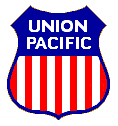 |
The Union Pacific is in one 30' by 26' room, and the Western branch line railroad (10' by 12' layout) is in another room. The UP layout began in 1978, and the Western layout was started by my son Steve in 1988, and was published in Model Railroader, Feb. 1990 (Page 128). With ten cities, there are now more than 140 Industries that could be switched from two main yards, and two small city yards. To help new crews, there are maps on the side of the layout with the city name, the industry names and their track location. Digitrax radio throttles are used for main line running, and the plug-in throttles are used for switching and yard operations. The two railroads are basically a loop-to-loop system with seven passing sidings. Radios are available for the crews and also the two main yard crews to communicate with a dispatcher in a separate workroom. Superintendent: Bob Frey Location: Greendale Web site: http://bobfrey.auclair.com Scale: HO Era: Summer 1950 Modeled Locale: Laramie to Granger, WY Interchanges with: Western Railroad Mainline: 400 ft. Scenery: 100% sceniced Motive Power: Steam and first-generation diesel Communication: Radios Fast Clock: No |
|
| Optoberfest Crew | ||
| 1. | Robert Prox | |
| 2. | Dennis Prox | |
| 3. | George Pulford | |
| 4. | Ron Burkhard | |
| 5. | Jeff Markey | |
| 6. | ||
| 7. | Mark Digerness (H) | |
| 8. | Bob Breaker/Tim Buechler (H) | |
| Afternoon Section |
|---|
All afternoon sessions start at 2:00 p.m., with the exception of the T&GR, and go until 5:00 p.m.ish. Please arrive between 1:30 p.m. and 2:00 p.m. so you have time to familiarize yourself with the railroad before the session begins. |
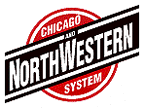 |
The West Wisconsin Railroad is loosely based on the C&NW in central and northern Wis., mostly modeling the areas around Eau Claire and north. Loop staging to stub end, single track main line with several passing sidings, a helix between decks, and two branch lines. Traffic is mostly grain, and wood/paper operations, with several through freights, lot of switching, and even a stack and ore train thrown in for variety. Superintendent: Mark Digerness Location: Germantown Web site: Photos of layout and pics from Milwaukee Operating Day 2012 on March 31. Scale: HO Era: 1990 Modeled Locale: Superior, WI to Chicago, IL Interchanges with: Wisconsin Central, CN, DM&IR and the Ironwood System. Mainline: 300 ft. Scenery: 75% sceniced Motive Power: Diesel Communication: Roving dispatcher Fast Clock: No |
|
| Optoberfest Crew | ||
| 1. | Roger Worchel | |
| 2. | David Wichman | |
| 3. | Mike Carlson | |
| 4. | Brian Hechel | |
| Extra Board | ||
| 5. | Don Drum | |
 |
This is an O scale version of previous N scale Trap N Garnet Ridge layouts. Naturally, the area modeled had to shrink, but staging still represents New Haven, CT and Springfield, MA. Conrail trains from staging arrive on the modeled portion of the layout at Berlin, CT, providing interchange traffic for the T&GR, whose tracks extend westward through central Connecticut to Waterbury. The layout was designed for dispatched operations, with ample switching despite not having any large yards. Four-foot wide aisles throughout the layout room make operating even with two-man crews enjoyable. Superintendent: Mike Hurlburt Location: Sugar Creek (Elkhorn area) Web site: Photos of layout Scale: O Era: 1984 Modeled Locale: Central Connecticut Interchanges with: Conrail Mainline: 225 ft. Scenery: 20% sceniced Motive Power: First and second-generation diesel Communication: Verbal Fast Clock: No |
|
| Optoberfest Crew | ||
| 1. | Andy Sperandeo | |
| 2. | Gordy Spiering | |
| 3. | Jeff Markey | |
| 4. | Jim Baker | |
| 5. | Bob Frey (H) | |
| 6. | Bob Breaker/Tim Buechler (H) | |
| Evening Section |
|---|
Sessions begin at 7:00 p.m. While open to everyone, hosts and helpers from the morning and afternoon session will get first dibs at these sessions as they have made the morning and afternoon sessions possible, and may want the chance to operate on someone elses railroad as well. |
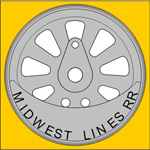 |
An HO freelanced railroad between Denver and Kansas City set in the early 1960s. The fully sceniced layout features motive power from the UP, RI, and CB&Q. It uses Lenz DCC and computerized switchlists with radios provided for communication with the dispatcher. The layout was featured on the PBS series Tracks Ahead (fourth season, episode #408 in 1998) Superintendent: Rolf Plachter Location: Racine Web site: www.midwestlines.org Scale: HO Era: 1960-1965 Modeled Locale: Kansas City, MO to Denver, CO Interchanges with: CB&Q, Rock Island, Union Pacific Mainline: 300 ft. Scenery: 100% sceniced Motive Power: First-generation diesel Control System: Lenz Digital Plus DCC Communication: Radios Fast Clock: No |
|
| Optoberfest Crew | ||
| 1. | George Pulford | |
| 2. | Ron Burkhard | |
| 3. | Paul Hanson | |
| 4. | Mike Hirvela | |
| 5. | Dave Poquette | |
| 6. | Richard Koch, Jr. | |
| 7. | Jim Allen | |
| 8. | Dewane Nerison | |
| 9. | ||
| 10. | ||
| 11. | ||
| 12. | Tim Buechler | |
| 13. | Gary Children | |
| 14. | Ken Jaglinski (H) | |
 |
The Norfolk & Whey Railroad, also referred to as the NFW after its reporting marks, is a prototype-based freelance model railroad inspired by Norfolk Southern’s Pocahontas Division in the coal country of southern West Virginia. Superintendent: Tim Hensch Location: Milwaukee Web site: www.nfwrailroad.com Scale: HO Era: Present Modeled Locale: Bluefield to Williamson, WV Interchanges with: NS Mainline: 360 ft. Scenery: 10% sceniced Motive Power: Modern diesel Communication: Radios Fast Clock: No |
|
| Optoberfest Crew | ||
| 1. | Roger Worchel | |
| 2. | David Wichman | |
| 3. | Shane Lambert | |
| 4. | Lynn McMahon | |
| 5. | Bob Sherman | |
| 6. | Rell Barrett | |
| 7. | Brian Hechel | |
| 8. | Mark Digerness (H) | |
| 9. | Ken Thompson (H) | |
| 10. | Reserved by host | |
Why is the schedule the way it is and it seems certain layouts are always in the morning or afternoon? The layouts are schedule first on the basis of the hosts preference for which time of day they want to host a session, if they have one. From there the layouts are assigned a time which allows for a balanced (or close to it) number of crews between the morning and afternoon sessions. As the hosts make this day possible, their requests are honored.
Why don't you have any layouts closer to where I live? While there are more railroads out there, these are the ones which have stepped forth to participate in this event. Nobody was turned down. At least five new layout owners have indicated an interest in participating in future events, so there could be new layouts in new areas in the future.
Why do you do two of these a year? After the first one a survey was taken and the results were a clear majority wanted to do this twice a year - once in the early fall and once in the early spring. Everyone who participates has fun, so we keep doing it. It has been suggested there be four a year, but that would be too much of a good thing (and too much for the hosts and organizer).
There are a few resources you may find helpful before, or after, Optoberfest.
• WiThrottle App for iPhone
• Engine Driver Throttle for Android
• WISE JMRI Operations (a Yahoo discussion group for those in Southeastern Wisconsin using JMRI Operations for car routing.)
• Milwaukee-area Railfan Guide (for those of you not familiar with the area, this guide is a map which includes railroad-related places you may find interesting as you go from layout to layout.)
Updated October 26, 2012